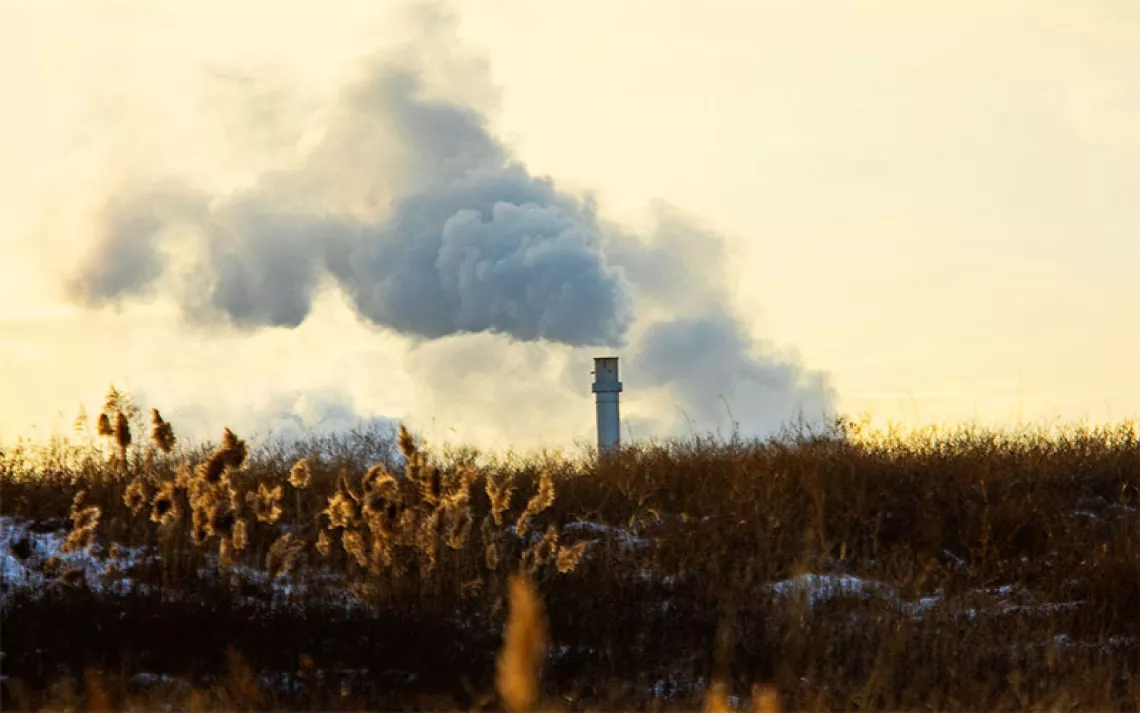10 Industrial Plants Emit 70 Percent of Pittsburgh-Area Air Pollution
Coal and steel facilities round out PennEnvironment’s new “Toxic Ten” report

Photo by sdominick/iStock
Over the last two decades, Pittsburgh has consistently turned up in rankings of the most livable cities in the United States, topping lists from the Economist to Forbes to Livablity.com. While that may be a reality for some residents, for others, just breathing the air could be dangerous, even deadly, as a new report released today makes clear.
Ten facilities are responsible for more than 70 percent of all the industrial air pollution in Pennsylvania’s Allegheny County, according to the new Toxic Ten report released today by PennEnvironment. That pollution includes heavy metals and other toxic substances that have been linked to health problems such as asthma, birth defects, and cancer. Out of those 10, the Cheswick Generating Station, a coal-fired power plant sited along the Allegheny River, was named the number one most polluting facility, responsible for emitting over 300 pounds of arsenic and over 200 pounds of chromium—in addition to lead, manganese, mercury, and other toxic pollutants—into the air in 2016 alone.
PennEnvironment, a state environmental group, released its first Toxic Ten report in 2015. The analysis uses self-reported industry statistics and EPA Toxics Release Inventory data to examine and rank industrial facilities having the biggest impact on public health. The report, which covers data available through 2016, analyzes not only how much those facilities are polluting, but also the degree of toxicity of that pollution.
“If you pull up a map of the United States and point to anywhere on it, you’re almost guaranteed to be safer breathing there than in Allegheny County,” says Zachary Barber, the Western PA field organizer for PennEnvironment. “The biggest single chunk of that comes from these industrial sources.”
Allegheny has some of the worst air pollution in the country due to its concentration of industrial polluters. County-wide reports have found that air throughout the region can be dangerous to breathe, with one study from the University of Pittsburgh Graduate School of Public Health finding that the county was in the top 2 percent in the United States for cancer risk from air pollution. Last year, the American Lung Association’s annual State of the Air report named the Pittsburgh region among the worst in the nation for year-round particle pollution, coming in at number eight of the 25 most polluted cities.
According to the Toxic Ten report, the Cheswick Generating Station is the largest emitter of nitrogen oxides and sulfur dioxide in the county, the largest emitter of lead and mercury, and one of the top five largest sources of benzene and carbon monoxide. It is also a large source of water pollution, dumping nearly 400 pounds of lead into the Allegheny River in 2016. More than 30,000 people live within three miles of the plant. Cheswick is also one among a dozen coal-fired power plants in the commonwealth that has been operating under an expired water-pollution permit. Last year, environmental groups including the Sierra Club, PennFuture, and Lower Susquehanna Riverkeeper Association sued the Pennsylvania Department of Environmental Protection in a bid to force the agency to enforce its own laws and bring Cheswick and other plants into compliance with updated water permits. The case was settled last month.
But coal-fired power plants aren’t the only cause of the county’s pollution problems. While a common perception about Pittsburgh is that the region’s steel days are behind it, the Toxic Ten report makes clear that this isn’t the case. The number two and number three most polluting facilities, respectively, are the ATI Flat Rolled Products plant in Brackenridge, a stainless-steel plant located in the north of Allegheny County, and the USS-Clairton Plant, known as Clairton Coke Works, which provides fuel for a nearby steel furnace. ATI, which emits sulfur oxides and carbon monoxide among other pollutants, has never been issued an air quality permit. Clairton, meanwhile, has been operating under an expired air quality permit since 2012 and emits such high levels of heavy metals and other pollutants that in 2017, the Allegheny County Health Department concluded that the plant had violated air pollution standards some 6,700 times in the previous three and a half years. Just under 20,000 people live within three miles of ATI; over 36,000 people live within three miles of Clairton.
The McConway & Torley steel foundry, coming in at number 10, dropped a few spots in the rankings after successful efforts to work with the Allegheny County Health Department and the company operating the plant to get its emissions under control, according to Barber. The foundry, which emits lead, chromium, and manganese, is located in one of the most densely populated neighborhoods in Pittsburgh. Nearly 150,000 people live within three miles of the facility.
Rounding out the “Toxic Ten” list is a rock-crushing company and a number of chemical plants, including the Pressure Chemical Company in Pittsburgh, which emits chloroform into the air. The ATI Powder Metals facility emits a lower volume of pollution compared to others on the list, but what it is emitting—a finely ground metal—is one of the most toxic forms of pollution. About 40,000 people live within three miles of the plant.
In tandem with the report’s release, PennEnviornment also published an online tool that Allegheny County residents can use to locate the nearest “Toxic Ten” industrial plant. For example, parents of students at Highlands High School will find that there are two toxic facilities within about a mile of the school.
“These facilities are located in incredibly dense urban environments where pollutants impact a lot of people,” Barber says. “Many of these other facilities like Brackenridge or Clairton are located right inside residential areas, which means that this pollution we’re talking about isn’t some abstract thing. It’s unfortunately part of the daily life of people here in Allegheny County.”
There were some modest decreases in overall emissions from the 2015 Toxic Ten report due to improvements in technology. But according to Barber, there hasn’t been a meaningful improvement in air quality as it relates to people’s health. He says that with the latest report, PennEnvironment is looking to give community members a tool to understand what’s in their air. The group is also hoping to provide a road map for local leaders, county executives, and the county health department to help them see where they need to focus their efforts to improve air quality.
“I’m baffled that we’re able to keep our reputation as one of the most livable cities in the country if breathing the air will make you sick,” Barber says. “That’s not livable.”
 The Magazine of The Sierra Club
The Magazine of The Sierra Club



